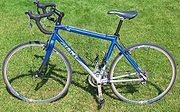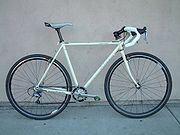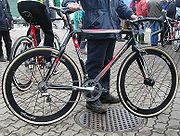
Cyclo-cross bicycle
Encyclopedia

Bicycle
A bicycle, also known as a bike, pushbike or cycle, is a human-powered, pedal-driven, single-track vehicle, having two wheels attached to a frame, one behind the other. A person who rides a bicycle is called a cyclist, or bicyclist....
specifically designed for the rigors of a cyclo-cross
Cyclo-cross
Cyclo-cross is a form of bicycle racing. Races typically take place in the autumn and winter , and consists of many laps of a short course featuring pavement, wooded trails, grass, steep hills and...
race. Cyclo-cross bicycles roughly resemble the racing bicycle
Racing bicycle
A racing bicycle, also known as a road bike, is a bicycle designed for competitive road cycling, a sport governed by according to the rules of the Union Cycliste Internationale...
s used in road racing
Road bicycle racing
Road bicycle racing is a bicycle racing sport held on roads, using racing bicycles. The term "road racing" is usually applied to events where competing riders start simultaneously with the winner being the first to the line at the end of the course .Historically, the most...
. The major differences between the two are the frame geometry, and the wider clearances that cyclo-cross bikes have for their larger tires and mud and other debris
Road debris
Road debris, a form of road hazard, is debris on or off a road. Road debris includes substances, materials, and objects that are foreign to the normal roadway environment...
that they accumulate.
Frame design
FrameBicycle frame
A bicycle frame is the main component of a bicycle, on to which wheels and other components are fitted. The modern and most common frame design for an upright bicycle is based on the safety bicycle, and consists of two triangles, a main triangle and a paired rear triangle...
materials are selected with an aim to produce a lightweight, yet stiff and responsive frame. Lightness is prized for ease of carrying while running. A cyclo-cross racer may lift or carry their bike as many as 30 times in one 60 minute race, increasing the desire for a lightweight bicycle. Aluminum frames were popular in cyclo-cross bicycles long before they became commonplace on the road. Today the most popular material is aluminium with carbon fiber
Carbon fiber
Carbon fiber, alternatively graphite fiber, carbon graphite or CF, is a material consisting of fibers about 5–10 μm in diameter and composed mostly of carbon atoms. The carbon atoms are bonded together in crystals that are more or less aligned parallel to the long axis of the fiber...
being popular at a professional level and steel
Steel
Steel is an alloy that consists mostly of iron and has a carbon content between 0.2% and 2.1% by weight, depending on the grade. Carbon is the most common alloying material for iron, but various other alloying elements are used, such as manganese, chromium, vanadium, and tungsten...
and titanium
Titanium
Titanium is a chemical element with the symbol Ti and atomic number 22. It has a low density and is a strong, lustrous, corrosion-resistant transition metal with a silver color....
being favorites amongst riders searching for a smoother ride and a longer lasting frame.
Cyclo-cross frames require clearance for slightly wider (generally 30–34 mm) tires and the debris and mud that is picked up by them. They are typically very simple, often eschewing bridges between the rear stays. Compact geometry frames with sloping top tubes are less common than on road bicycles due to the need to carry the bicycle easily on the shoulder. Top tube (rather than bottom bracket
Bottom bracket
The bottom bracket on a bicycle connects the crankset to the bicycle and allows the crankset to rotate freely. It contains a spindle that the crankset attaches to, and the bearings that allow the spindle and cranks to rotate. The chainrings and pedals attach to the cranks...
) routed derailleur
Derailleur gears
Derailleur gears are a variable-ratio transmission system commonly used on bicycles, consisting of a chain, multiple sprockets of different sizes, and a mechanism to move the chain from one sprocket to another...
cables
Bowden cable
A Bowden cable is a type of flexible cable used to transmit mechanical force or energy by the movement of an inner cable relative to a hollow outer cable housing...
help combat the build-up of mud. Some specialist cyclo-cross bikes also have a higher bottom bracket to aid clearance over rough ground; extra clearance could prevent toe clips from dragging while re-mounting after an obstacle. This is less common as clipless pedals
Bicycle pedal
A bicycle pedal is the part of a bicycle that the rider pushes with their foot to propel the bicycle. It provides the connection between the cyclist's foot or shoe and the crank allowing the leg to turn the bottom bracket spindle and propel the bicycle's wheels...
have become the norm for cyclo-cross.
Typically, the frame geometry is a bit more relaxed than that of a road bike, not as upright in the seat tube, which allows for more shock absorption. Also, the wheelbase is a bit longer, which provides a more stable feel over rough terrain, and helps keep the rider's feet from contacting the front wheel during a tight turn.
Components
Choices of equipment tend more towards the idiosyncratic than in road racing; for example single-speed bicycleSingle-speed bicycle
A single-speed bicycle is a type of bicycle with a single gear ratio. These bicycles are without derailleur gears, hub gearing or other methods for varying the gear ratio of the bicycle....
s also have some popularity due to the advantage of mechanical simplicity in the often very muddy conditions and the fringe nature of the sport. Gearing is typically lower, with most common setups using a 46-38 chainring combination with a 12-27 cassette
Cassette (bicycle part)
On a bicycle, the cogset or cluster is the set of multiple rear sprockets that attaches to the hub on the rear wheel. A cogset works with a rear derailleur as part of the drivetrain to provide multiple gear ratios to the rider. Cogsets come in two varieties, cassettes or freewheels, of which...
. Some riders opt to use a single chainring in the front (typically a 40-42 tooth chainring) while retaining multiple sprockets in the rear cassette. This has some of the advantages of the single-speed: the weight of the front derailleur and the front shift lever are lost, a single chainring allows for a tighter chainline, thus reducing the chance of throwing a chain on a bumpy course, and further, racing is psychologically simpler.
Wheels
Bicycle wheel
A bicycle wheel is a wheel, most commonly a wire wheel, designed for bicycle. A pair is often called a wheelset, especially in the context of ready built "off the shelf" performance-oriented wheels....
are of the normal road racing type fitted with knobby tires (a variety of tread designs in both tubular and clincher types are available), although deeper rim profiles may be preferred for their advantages in thick mud. There are slight geometry differences between road and cyclocross bicycles; cyclo-cross bikes tend to have slightly higher handlebars
Bicycle handlebar
Bicycle handlebar or often bicycle handlebars refers to the steering mechanism for bicycles; the equivalent of a steering wheel. Besides steering, handlebars also often support a portion of the rider's weight, depending on their riding position, and provide a convenient mounting place for brake...
for a more upright position as aerodynamics have little importance in a cross race. A second set of brake levers on the tops, called top mount brake levers, are favored by some competitors. The top tubes of cyclocross bike frames typically have an ovalized or flattened bottom profile to provide greater comfort when riders need to shoulder and carry their bikes. In general, with a change of tires and gearing a cyclo-cross bike can double as a perfectly adequate road racing machine. However, most cyclo-cross racers prefer clipless mountain bike pedals for their easy dual-sided entry and mud-shedding abilities. Additionally, mountain biking shoes provide better traction while running than typical road style shoes thanks to flexibility in the sole and pronounced tread patterns.

With the recent lifting of the UCI ban on disc brake use in cyclocross racing, bike component and frame manufacturers have immediately started developing and testing race-level cyclocross bikes equipped with disc brakes. Many companies such as Specialized
Specialized Bicycle Components
Specialized Bicycle Components, more commonly known simply as Specialized, is a major American brand of bicycles and related products. It was founded in 1974 by Mike Sinyard and is based in Morgan Hill, California-History:...
, Stevens, and Redline are already field testing prototype disc-specific cyclocross bikes with upper-tier cyclocross racers. Specialized has recently demonstrated a near production ready variant of its CruX cyclocross bicycle outfitted with Avid mechanical disk brakes and rear dropouts
Dropout (bicycle part)
A bicycle dropout is a type of fork end that allows the rear wheel to be removed without first derailing the chain. The more inclusive term fork end refers to a slot in a frame or fork where the axle of the wheel is attached....
with 135mm wide spacing for compatibility with existing mountain bike disc hubs. Part of Specialized's 2012 product line includes a Crux equipped with disc brakes. Additionally, Redline recently announced that its next generation Conquest Carbon cyclocross frameset will be disc brake compatible. Since the UCI's repeal of the disc brake ban was reportedly lobbied by bicycle component maker Shimano, it can be inferred that the company has plans to introduce disc brake based cyclocross specific groupsets combining light, possibly hydraulic disc brake hardware with road-racing styled integrated brake levers/shifters.
Tires
Tire choice is very important in cyclo-cross racing. Tubular tires are still very popular; even more so than in road racing. This is, in part, due to their ability to be used at low pressure (22-40psi/1.5-2.75bar) without increasing the risk of pinch flats. Low pressure is desirable because it increases contact patchContact patch
Contact patch is the portion of a vehicle's tire that is in actual contact with the road surface. It is most commonly used in the discussion of pneumatic tires, , where the term is strictly used to describe the portion of the tire’s tread that touches the road surface...
area which can increase traction on soft surfaces. This increases the risk of the rim bottoming out on the ground, however, and this is a problem with clincher tires because the tube can be pinched by the rim, causing a flat. With tubular tires, this is not a problem, as they cannot pinch flat. The only concern is damage to the rim. Tubular tires also offer a weight saving and the ability to be ridden on even when flat so that a racer can reach the pits for a replacement.
Clinchers do have their advantages. Changing tires is much quicker since it does not involve a lengthy glueing and curing process so a rider can have a large selection of tires at their disposal. Until recently, clinchers also generally had more cutting edge tread patterns than the more traditional tubulars. Some enthusiasts even went as far as to send Michelin
Michelin
Michelin is a tyre manufacturer based in Clermont-Ferrand in the Auvergne région of France. It is one of the two largest tyre manufacturers in the world along with Bridgestone. In addition to the Michelin brand, it also owns the BFGoodrich, Kleber, Riken, Kormoran and Uniroyal tyre brands...
Mud tires (a popular clincher tire) to Dugast (a manufacturer of high end tubular tires) to have a modern tread pattern incorporated into a traditional tubular. However, since 2005 several tubular manufacturers have designed more modern style tread patterns, namely Dugast with its Rhino, Tufo with its Flexus and Challenge with its Grifo and Fango. Lastly, clincher tires generally cost less than tubulars.
Because cyclo-cross season spans autumn/fall and winter, course conditions can vary quite drastically. Often racers have at least dry and wet weather tires to choose between. Dry tires tend to have much smaller, closely spaced tread such as the diamond pattern for low rolling resistance. Wet weather tires have larger and more widely spaced knobs to aid in grip and mud shedding. Tires do not usually vary in width a great deal due to the theory that a narrow tire has the least rolling resistance (for dry courses) and that it will also cut through mud to the harder ground underneath (for wet/muddy courses). Although widths below 30c were popular in the past, current tires tend to be available from 30-35c with 32 and 34 being the most common.
Equipment choice

Rules
The following are rules that have been put in place by the UCIUnion Cycliste Internationale
Union Cycliste Internationale is the world governing body for sports cycling and oversees international competitive cycling events. The UCI is based in Aigle, Switzerland....
that are either specific to or have particular effect on cyclo-cross bicycles. Bear in mind that these rules are not exhaustive, are only for UCI-sanctioned events and may not be enforced at all cyclo-cross events.
- Handlebars must not measure more than 50 centimetres (19.7 in) in width.
- Tire width may not exceed 33 millimetres (1.3 in) and tires may not feature any kind of studs or spikes.
- Wheels shall have at least 12 spokes.
- The bicycle must not weigh less than 6.8 kilograms (14.99 lb).
Disc brakes have recently been allowed for UCI races.
Non-racing use
In recent years, some cyclo-cross bicycles available in the consumer market are supplied with disc brakes as a stock item. In general these bicycles have braze-ons to enable the use of cantilever style brakes instead.Cyclocross bikes are growing in popularity amongst consumers for their versatility: they have some of the geometry and aerodynamic benefits of road bikes, but take wider tires, sometimes have braze-ons for fenders and racks, and are rugged enough for off-road and touring use.
Mountain bikes
In some countries (including the United States, so long as it is not a UCI event) riders are also permitted to race in cyclo-crossCyclo-cross
Cyclo-cross is a form of bicycle racing. Races typically take place in the autumn and winter , and consists of many laps of a short course featuring pavement, wooded trails, grass, steep hills and...
events using mountain bike
Mountain bike
A mountain bike or mountain bicycle is a bicycle created for off-road cycling. This activity includes traversing of rocks and washouts, and steep declines,...
s (generally without bar ends), at least in low-level competition, but this is not currently allowed in events on the international calendar. It has been known for local races to be won on mountain bikes, particularly if the course is technical with little road or fast sections. However, for a traditional cyclo-cross course a cyclo-cross bicycle is the most suitable tool for the job.

